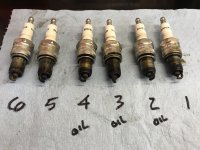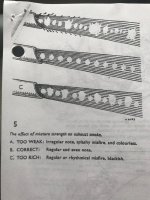AUSMHLY
Obi Wan
Offline
I just got my carbs back from having new throttle bushing installed.
Ready to do a tune up.
I ran the following questions by a very competent Healey guy yesterday and thought I'd run this by the forum, just in case someone else had/has this same situation.
I removed 6 spark plugs yesterday to find they are all black, which I understand means it's running rich.
(Not sure if that's related to a possible vacuum leak or if I tuned them too rich. I can cross off throttle shaft leak from here on out.)
I found oil on plugs 4,3,2... thread only, not the tips.
I did a compression test. (6)145 (5)140 (4)140 (3)145 (2)130 (1)148
Should I be concerned about 130 pounds of compression on #2? Why is that?
Why do I have oil on the threads of plugs 4,3,2.
I've never had any luck getting as an even a pressure flow out of the left exhaust pipe as I do with the right (facing the rear of the car).
The left exhaust pipe connects to the front carburetor.
Which cylinders are for the front carburetor?
I understand when you adjust one carb it affect the other. I'm assuming because I can't get a smooth pressure out of the left pipe it's related to the front carb?

Ready to do a tune up.
I ran the following questions by a very competent Healey guy yesterday and thought I'd run this by the forum, just in case someone else had/has this same situation.
I removed 6 spark plugs yesterday to find they are all black, which I understand means it's running rich.
(Not sure if that's related to a possible vacuum leak or if I tuned them too rich. I can cross off throttle shaft leak from here on out.)
I found oil on plugs 4,3,2... thread only, not the tips.
I did a compression test. (6)145 (5)140 (4)140 (3)145 (2)130 (1)148
Should I be concerned about 130 pounds of compression on #2? Why is that?
Why do I have oil on the threads of plugs 4,3,2.
I've never had any luck getting as an even a pressure flow out of the left exhaust pipe as I do with the right (facing the rear of the car).
The left exhaust pipe connects to the front carburetor.
Which cylinders are for the front carburetor?
I understand when you adjust one carb it affect the other. I'm assuming because I can't get a smooth pressure out of the left pipe it's related to the front carb?

Last edited:

 Hey there Guest!
Hey there Guest!
 smilie in place of the real @
smilie in place of the real @
 Pretty Please - add it to our Events forum(s) and add to the calendar! >>
Pretty Please - add it to our Events forum(s) and add to the calendar! >> 



 A friendly reminder - be careful what links you click on here. If a link is posted by someone you don't know, or the URL looks fishy, DON'T CLICK. Spammers sometimes post links that lead to sites that can infect your computer, so be mindful what you click.
A friendly reminder - be careful what links you click on here. If a link is posted by someone you don't know, or the URL looks fishy, DON'T CLICK. Spammers sometimes post links that lead to sites that can infect your computer, so be mindful what you click.